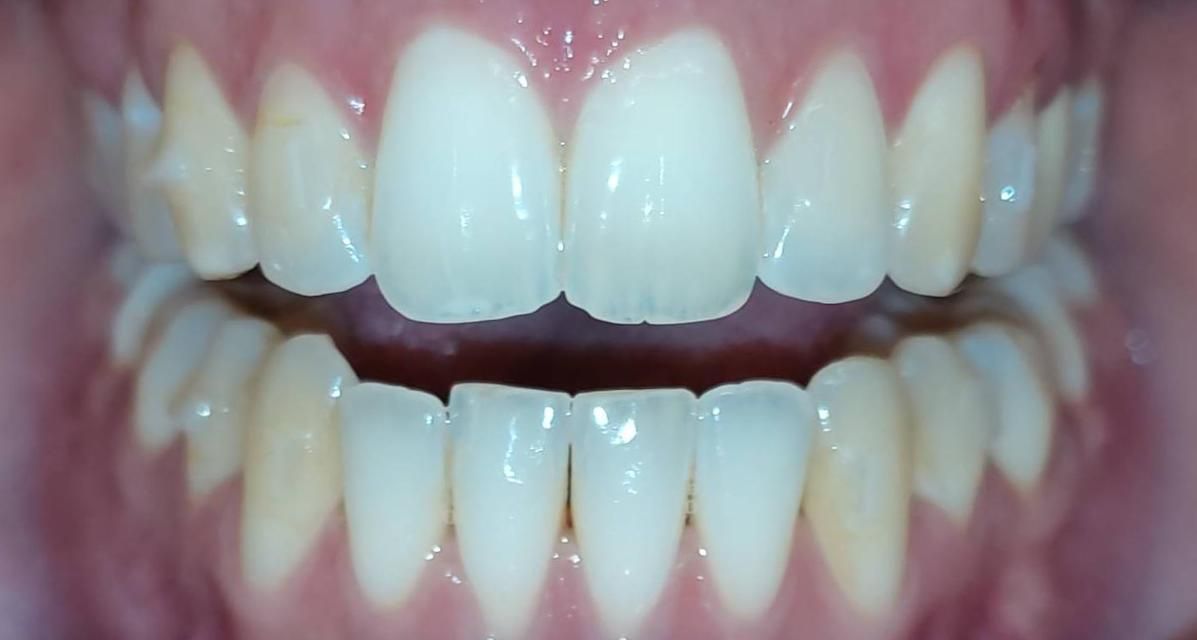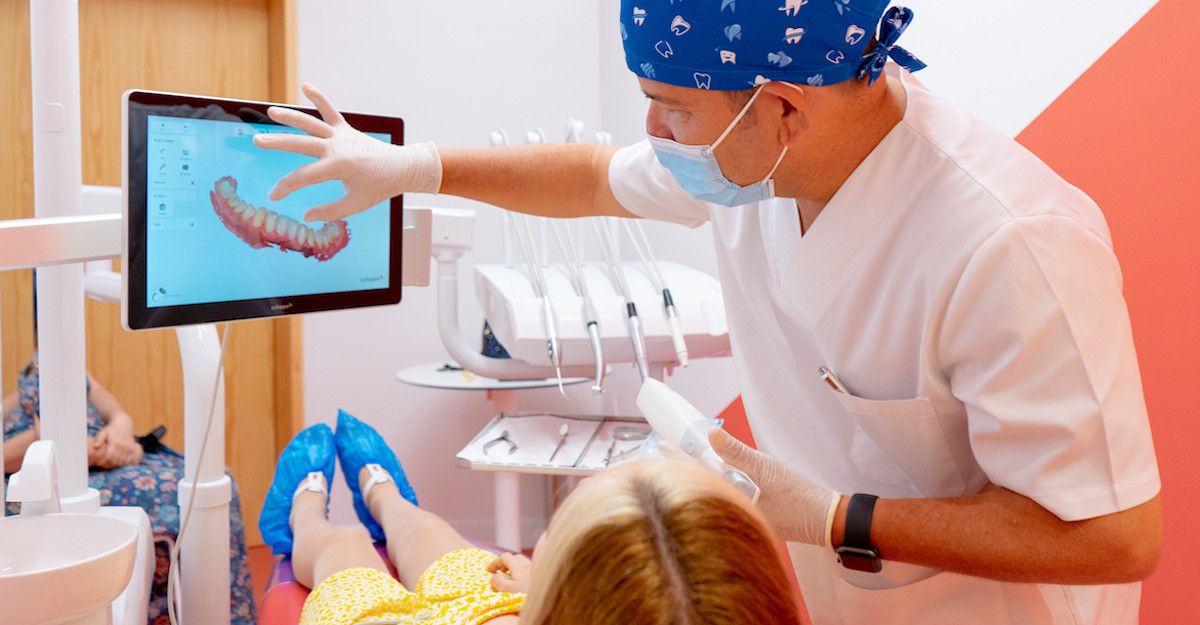Types, causes, and solutions for an open bite
An open bite is a prevalent form of malocclusion affecting the teeth. It is characterized by the inability of the affected person to close their mouth correctly due to the position of their teeth, which is visibly apparent.
Apart from the cosmetic implications, an open bite can cause difficulties in breathing, speaking, and chewing, and may also result in muscular discomfort. There are also mild, moderate and severe cases of open bite. We will describe the potential causes of an open bite, the associated effects on a patient's teeth health, and the available treatments for children and adults to correct the condition.
What is an open bite?
If you’re wondering what an open bite is—it’s a form of malocclusion where the front or back sets of teeth cannot close correctly, resulting in some areas without contact between the upper and lower arches of teeth. Patients suffering from this condition find it difficult to fit their teeth together correctly while biting.
The types of open bites
There are several types of open bite that vary depending on which teeth are not in contact with the opposing arch. We will examine the four distinct types of open bite that can occur, depending on which area of the occlusion is affected.
Posterior open bite
Posterior open bite is a form of malocclusion characterized by the lack of contact between the upper molars and lower molars at the back of the mouth, leading to incomplete occlusion. Unlike other types of open bite, this malocclusion is not immediately visible to the naked eye as it occurs on the inside of the mouth.

Anterior open bite
Among the various types of open bite, the anterior open bite is the most prevalent. This condition arises when the front teeth in the upper and lower arches do not come together correctly, resulting in a gap between them. It is the most apparent form of open bite, as the gap between the front teeth is visible.
Lateral open bite
A lateral open bite is a form of malocclusion that affects only one side of the mouth, either the left or right. In this condition, there is a lack of contact between the upper and lower teeth on only one side, resulting in incomplete occlusion.
Complete open bite
In a complete open bite, both posterior and anterior teeth are affected. This type of malocclusion causes only the last molars to make contact, leading to a lack of occlusion between some molars and all front teeth.
What causes an open bite?
The causes of open bite can be a variety of factors, and some of them may be beyond our control, such as genetic predisposition.
We will discuss the common what the causes of open bite are, as well as the habits that can contribute to the development of open bite and ways to prevent them.
Open bite due to genetics or a skeletal problem
Some genetic conditions can lead to abnormal skeletal development, resulting in an open bite. In such cases, a child may inherit a poor skeletal relationship between their upper and lower jaws from one of their parents, causing their teeth to not fit together correctly when biting down.
Most causes of open bite are noticeable during childhood and adolescence, which presents an opportunity to address and potentially correct or mitigate developmental dental and jaw problems before they become more severe in adulthood.

Open bite from thumb sucking or pacifier use
Wondering if your kid’s pacifier is causing them to have an open bite? Open bite conditions are commonly caused from prolonged pacifier use or thumb sucking. While some sucking is a natural part of oral development, continued use of a pacifier, finger, or thumb beyond 18-24 months of age can physically alter a child's jaw, palate, and facial structure, resulting in skeletal changes that contribute to kids with both a mild or severe open bite.
When a child constantly sucks on a pacifier or thumb, their front teeth cannot close together properly, causing a noticeable open bite between their upper and lower front teeth when they bite down. This is not a normal, healthy, or developmentally appropriate condition.
Tongue thrust causing open bite
Tongue thrust is a significant cause of open teeth bites, along with thumb sucking and pacifier use. It occurs when someone does not swallow correctly, and instead of pushing their tongue up towards the roof of their mouth, the tip of their tongue presses forward into their front teeth.
Tongue thrusting can be identified by the visibility of the tongue tip through the front teeth when swallowing. This abnormal swallowing pattern is often the result of prolonged thumb or pacifier sucking. The constant pressure of the tongue against the front teeth can prevent them from properly closing together, resulting in an open bite. It is the opposite effect of wearing braces.
Open bite from mouth breathing
Mouth breathing can cause malocclusion problems like open bite by disturbing the natural development of teeth and muscles, thus causing them to deviate from their proper positions. This is due to mouth breathing causing changes in muscle and teeth positions that would not have occurred otherwise.
Side effects of an open bite
An open bite can result in various health problems, aside from its aesthetic impact. The following are the significant side effects of having an open bite and the associated health concerns:
- Speech problems: An open bite can result in speech problems as it hinders the mouth from closing correctly, making it difficult to pronounce certain phonemes. The tongue is not positioned correctly due to the open bite, which can lead to difficulties in speech.
- Difficulties in biting and chewing: As the upper and lower teeth do not come together properly with an open bite, this can lead to issues with biting and chewing. This can make it challenging to chew certain foods, which can result in digestive issues.
- Respiratory problems: These issues can arise due to an open bite, as it can cause mouth breathing which can further exacerbate the problem. An open bite can encourage malocclusion, which can lead to breathing difficulties through the mouth.
- Temporomandibular disorder (TMD): An open bite can cause tension and stress on the muscles and joints of the jaw, leading to TMD. This can result in symptoms such as headaches, neck pain, or bruxism.
How to fix an open bite: treatments and solutions
Various treatments are available to treat and fix an open bite, and the selection of the most suitable one depends on the patient's age and the severity of the malocclusion. In the following sections, we will examine the most appropriate remedies for fixing an open bite based on each age group.
Open bite in kids
When kids are in the developmental stage is an ideal time to address an open bite with a treatment that can prevent complications in adulthood. Interceptive orthodontics is the most appropriate course of action for correcting an open bite in kids, and we will delve into the specifics below.
Interceptive orthodontics
Interceptive orthodontics, utilizing various devices, is the most prevalent method of correcting open bite in kids. Frequently, appliances such as grids are included to halt the habit that causes the open bite. In cases where swallowing issues contribute to the open bite, these devices can also assist in repositioning the tongue. However, this type of treatment is only efficacious in children, as there is no possibility of further intervention once the bones are fully formed.

How to fix an open bite in adults
Wondering how to fix an open bite in adults? Interceptive orthodontics is not a viable option for treating or fixing open bite in adults, as bone growth has ceased at this stage. However, there are alternative approaches for correcting open bite in adults, including surgical and non-surgical options, which we will explore in the following sections.
Open bite surgery
Severe cases of open bite can be treated with surgery. Typically, this involves a pre-operative orthodontic phase to properly position each tooth, followed by surgery to modify the size and position of the upper and lower jaws to correct the open bite. Post-surgery, orthodontic treatment is resumed to finalize the treatment, fix the open bite, and achieve a harmonious smile.
Orthodontic treatments for non-surgical open bite correction
Can an open bite be fixed without surgery? Non-surgical approaches can correct mild to moderate cases of open bite in adolescents and adults. For instance, using aligners or braces with orthodontic treatment can address malocclusion and correct the open bite.
In open bite cases, orthodontic treatment with aligners or braces involves modifying the malocclusion with intrusion or extrusion movements on the anterior or posterior teeth, depending on the type of open bite. Auxiliary elements like micro-screws may also be required in some cases.
Impress treatments for open bite
Can clear aligners fix an open bite? At Impress, we provide orthodontic solutions for open bite correction regardless of age, catering to kids, teens, and adults alike. In the case of teens and adults, we provide various orthodontic treatments, including Impress clear aligners, which are ideal for discreet and can fix an open bite.
Our team of professionals is dedicated to helping you achieve optimal oral health and perfect occlusion. To get started, schedule your free consultation with us at your nearest Impress clinic via phone at +1 628.265.8188, email at careteam@smile2impress.com, or online. We look forward to helping you achieve your desired results.



